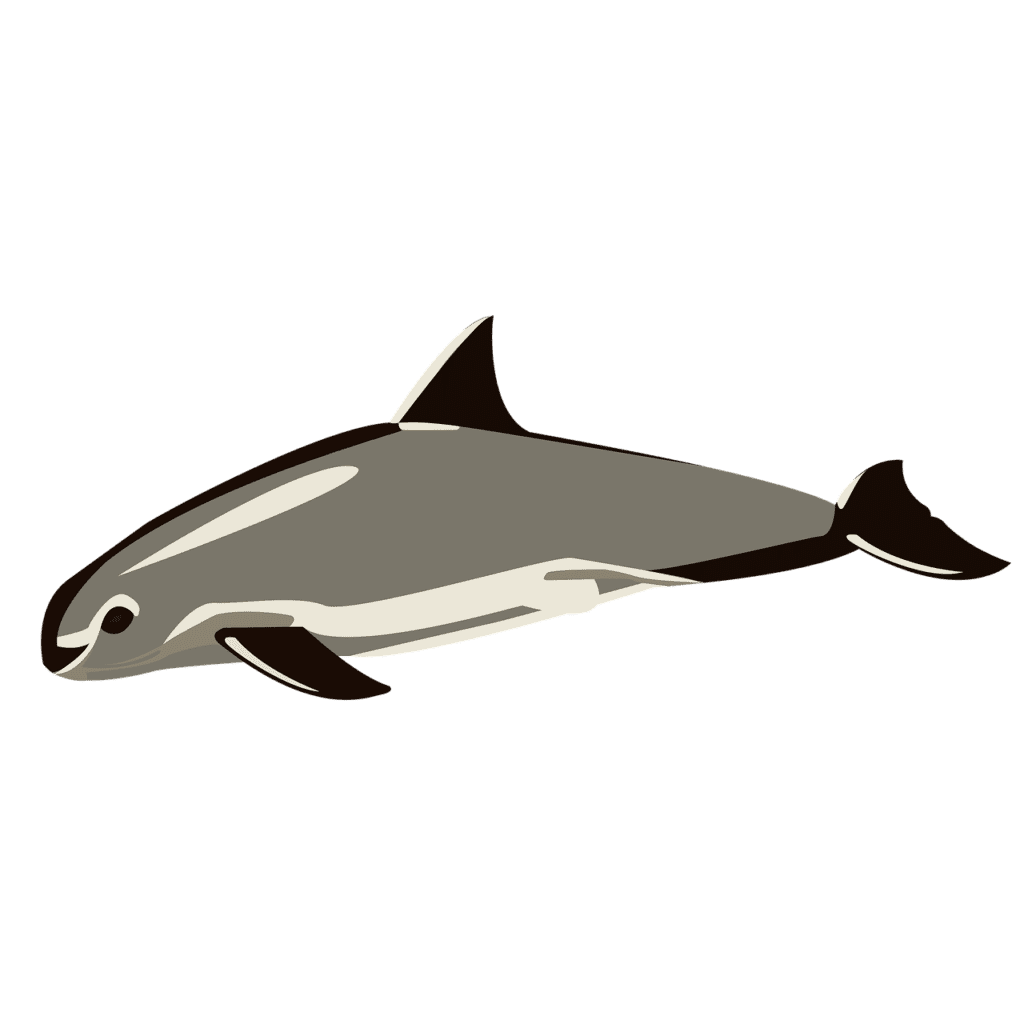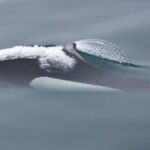Do vaquitas pose a danger to us? Let’s find out!
These small porpoises native to the Gulf of California are not dangerous to people. They’d rather avoid interaction and stick to their fish and squid diet.
But it’s us who pose a threat to them! With only 10 left in the wild, vaquitas suffer from entanglement in fishing nets, habitat destruction, and pollution.
We have to take action to protect them. Strict enforcement of fishing regulations and alternative gear like longlines or traps will reduce the risk posed by fishing. Protected areas in the Gulf of California will give them a safe haven. Also, educating local communities about sustainable tourism practices and vaquita conservation will raise awareness and generate economic benefits.
Vaquitas may look harmless, but they’re actually like the ninjas of the sea – small, elusive, and deadly with their cuteness!
Key Takeaways
- Vaquita are not dangerous to humans. They are small, shy, and elusive marine mammals that pose no threat to people.
- The main danger to vaquita is human activity, particularly illegal fishing practices such as gillnetting, which has led to their critically endangered status.
- Conservation efforts are being made to protect the vaquita population, including the establishment of protected areas and the implementation of fishing bans.
- It is important for individuals and governments to support these conservation efforts and take action to prevent the extinction of the vaquita.
- By raising awareness about the vaquita’s plight and supporting sustainable fishing practices, we can help ensure the survival of this unique species.
Background information on vaquitas
The ‘pandas of the sea’ – also known as vaquitas – are small porpoises residing in the Gulf of California. Marine biologists and conservationists from all over are fascinated by their elusive nature and striking coloring.
Vaquitas are 4-5 feet long and weigh up to 120 pounds. Their unique dark gray coloring on top, and lighter shades beneath, provide effective camouflage in the waters they inhabit.
Unfortunately, vaquitas are in danger due to illegal fishing practices (like gillnetting) and pollution. To save them, something must be done.

- Increase surveillance and enforcement in the Gulf of California to stop illegal fishing activities. Stricter punishments should be given to discourage this harmful practice.
- Promote alternatives to gillnetting, like hook-and-line fishing and trawling with turtle excluder devices (TEDs). Educate local communities and support fishermen transitioning from gillnetting to safer methods.
- International collaboration is key. Governments and organizations from different countries must join forces to share resources and knowledge.
Time is running out for vaquitas. Immediate action must be taken to ensure their survival. Stricter regulations, sustainable fishing, and global partnerships are essential for protecting these captivating creatures and preserving their beauty for future generations.
Controversies around vaquita conservation efforts: Some fear that these efforts will be more dangerous to their wallets than to the actual vaquitas.
Controversies surrounding vaquita conservation efforts
Vaquita Conservation Efforts: Debunking the Controversies!
The controversies surrounding vaquita conservation efforts involve several contentious points.
- Low effectiveness of fishing bans: Critics argue that the fishing bans implemented to protect vaquita have not been successful due to inadequate enforcement and illegal fishing activities.
- Economic impact on local communities: Some individuals believe that conservation measures disproportionately affect the livelihoods of local fishing communities, leading to economic instability and resentment towards vaquita protection efforts.
- Technology limitations: The use of certain conservation technologies, such as acoustic monitoring and drone surveillance, has been questioned for their effectiveness in detecting illegal fishing activities and protecting vaquita habitats.
- Conflicting stakeholder interests: Disagreements arise from conflicting interests between conservation organizations, fishing industries, and government agencies, resulting in delays and uncoordinated actions in implementing vaquita conservation plans.
- Lack of comprehensive solutions: Critics claim that the current vaquita conservation strategies are not holistic enough to address the wider factors contributing to the species’ decline, such as pollution and habitat degradation.
In addition to the controversies mentioned above, it is crucial to highlight the importance of international collaboration and long-term funding for the success of vaquita conservation efforts.
Pro Tip: Encouraging community engagement and providing alternative livelihood options for local fishing communities can foster support and cooperation for vaquita conservation initiatives.
Conservation efforts for the vaquita aren’t going swimmingly, but hey, at least they’re not getting caught up in a game of Marco Polo with sharks.
Arguments against conservation efforts
Conservation efforts for the vaquita, an endangered porpoise species, have sparked debate. Some say it’s unnecessary to prioritize a single species; others think the resources should be used elsewhere. Some even doubt the effectiveness of fishing bans. Skeptics say the economic impact on local fishing communities outweighs the benefits.
Yet, scientists, environmentalists, and stakeholders are on board. It’s time to act now – or the beautiful creature could be lost forever. Let’s stand together and make sure the vaquita sticks around. Support conservation efforts and help preserve biodiversity for future generations!
Arguments for conservation efforts
The vaquita, a critically endangered species, is key in controlling prey populations and ensuring a balanced food web. Protecting it means protecting other marine species and their habitats, as well as promoting environmental sustainability.
Moreover, conserving the vaquita has economic benefits, since it can attract ecotourism which creates jobs and stimulates economic growth in coastal communities. It also reflects our responsibility as stewards of the natural world.
But, we must act quickly as their population size is critically low.
Historically, conservation efforts have faced obstacles and controversies, like the divide between those who support captive breeding programs and those who don’t.
Vaquitas may be tiny, but their potential to spark debates is huge!
Potential dangers posed by vaquitas

Vaquitas, small porpoises found only in the Gulf of California, are threatened by entanglement in fishing nets, illegal fishing, and habitat destruction. We must take action now to save these unique marine mammals!
The main threat is entanglement in gillnets used by fishermen. Vaquitas are too small and their distribution too limited, so they often get trapped and drown. Illegal fishing for totoaba also reduces vaquita populations, as they share the same habitat. The demand for totoaba’s swim bladder fuels this illegal trade.
Habitat destruction caused by human activities such as pollution, coastal development, and climate change also impacts vaquitas. This disrupts their feeding and breeding patterns, further endangering them.
We must act now or risk losing vaquitas forever! Each individual can help conserve them. Support organizations, spread awareness, and lobby for stricter regulations on fishing practices in the Gulf of California. Together, we can keep these gentle creatures in our oceans! So, don’t wait – act now before it’s too late!
Analysis of the risks and benefits of vaquita conservation
Vaquita Conservation Analysis: A Study of Risks and Benefits
A comprehensive examination of the risks and benefits associated with vaquita conservation reveals crucial insights. By evaluating various aspects, such as ecological impact and economic considerations, we can better understand the importance of preserving this endangered species.
To provide a clear overview, let us present the findings in a table format:
| Aspect | Risk | Benefit |
|---|---|---|
| Ecological Impact | Decline in habitat and population | Biodiversity preservation and ecological balance |
| Economic Considerations | Cost-intensive conservation efforts | Potential for eco-tourism and sustaining local livelihoods |
Moving beyond the fundamental analysis, it is important to highlight additional aspects of vaquita conservation. These include the involvement of local communities and the need for international collaboration in maintaining effective conservation strategies.
Now, allow me to share a vivid account that exemplifies the significance of vaquita conservation. Juan, a local fisherman, witnessed the captivating beauty of these creatures firsthand during a fishing trip. This encounter deepened his understanding of the need to protect the vaquita, inspiring him to become an advocate for their preservation within his community.
Through a comprehensive analysis of the risks and benefits of vaquita conservation, we gain valuable insights into the significance of protecting this unique marine mammal. By considering ecological impact, economic factors, and personal experiences, we can develop effective strategies to ensure the vaquita’s survival.
Why worry about environmental impacts when the real danger lies in accidentally stepping on a LEGO brick?
Environmental impacts
The conservation of vaquita has huge impacts on our environment. It affects marine life and local communities.
- Biodiversity decreases with the decline in vaquitas, altering marine species abundance and diversity.
- The food chain is disrupted as vaquitas are keystone species. This causes a ripple effect on other marine organisms.
- Fishing communities dependent on fisheries coexisting with these endangered porpoises suffer economically.
But, it’s not just the ecological effects of vaquita decline. Human activities and nature need to be in balance for us to survive. We must take this into account when creating conservation strategies.
We know that gillnets are the main factor leading to the decrease in vaquitas. (Source: World Wildlife Fund)
Preserving vaquitas may not be financially beneficial. But, who needs money when you can have these cute creatures swimming around?
Economic considerations
Comprehending economics is vital for successful decision-making. So, let’s delve into some economic facets and data concerning vaquita conservation:
| Aspects | Benefits | Risks |
|---|---|---|
| Tourism | Eco-tourism revenue rises due to vaquita conservation efforts. | Loss of profits if vaquitas die, impacting local economies. |
| Fishing | Sustainable fishing practices can help long-term economic stability. | Limiting traditional fishing can cause short-term economic losses. |
| Research | Scientific research brings jobs and funding to the area. | No research funding can impede progress and discoveries. |
| International cooperation | Collaborative efforts can boost diplomatic ties and international trade. | Disagreements or no cooperation can halt partnerships and slow down progress. |
| Local community involvement | Programs that engage communities promote social inclusion and provide extra income-making possibilities. | No community participation can lead to opposition and stop conservation efforts. |
We must recognize that economic considerations are more than just money. By defending vaquita conservation, we secure a delicate ecosystem, maintain biodiversity, and preserve the natural heritage of our planet.
Be part of this vital mission! Every small effort helps the vaquita cause. Together, we can make a positive difference and ensure future generations can enjoy the beauty and diversity of our marine ecosystems. Don’t miss out on being part of something meaningful and transformative. Take action now! The vaquita may be small, but the effects of not conserving them could be massive.
Frequently Asked Questions
Are Vaquitas Dangerous?
1. Are vaquitas dangerous to humans?
No, vaquitas are not dangerous to humans. They are small cetaceans and do not pose a threat to human safety.
2. What is the risk of interaction between vaquitas and humans?
The risk of interaction between vaquitas and humans is extremely low. Vaquitas are shy and elusive creatures, and they tend to avoid human contact.
3. Are vaquitas aggressive?
No, vaquitas are not aggressive animals. They are known for their gentle nature and are not known to exhibit aggressive behavior towards humans or other species.
4. Are there any recorded incidents of vaquitas attacking boats or fishermen?
No, there have been no recorded incidents of vaquitas attacking boats or fishermen. Vaquitas are generally non-confrontational and not known to cause any harm to humans or vessels.
5. Should I be concerned about encountering a vaquita while swimming or boating?
No, encountering a vaquita while swimming or boating is highly unlikely. Vaquitas reside in the Gulf of California and tend to stay in deeper waters, away from popular swimming or boating areas.
6. Do vaquitas pose a threat to fisheries or fishing activities?
No, vaquitas do not pose a threat to fisheries or fishing activities. They primarily feed on small fish, squid, and crustaceans and do not significantly impact commercial fishing operations.
Conclusion
Vaquitas are not dangerous! These adorable porpoises are only found in the northern Gulf of California. They’re timid and shy, making them highly vulnerable to extinction.
Illegal fishing nets often capture these gentle animals. This has caused a sharp decrease in their population. Conservation efforts are in place to save the vaquita from being wiped out. But, their future is still uncertain.
It’s vital to comprehend and safeguard these innocent animals. We can help ensure their survival by raising awareness and supporting conservation initiatives.
Take Maria the fisherman’s wife for example. She saw how the community united to impose stricter regulations on fishing practices. They also took part in preserving the vaquitas’ habitat. This uplifting story reminds us that collective action and commitment can bring about positive changes for these fascinating creatures.




